Key Points:
- Guide dogs help the visually impaired people navigate safely as they walk at home or in public.
- People who are prone to seizures may benefit from owning a seizure response or seizure alert dog. These dogs receive two years of training and can even sense a seizure before it begins.
- Psychiatric assistance dogs, also known as therapy dogs and PTSD dogs, can aid people dealing with mental health disorders. They are trained to help calm symptoms of a panic attack and help de-escalate or relieve emotional breakdowns, among other things.
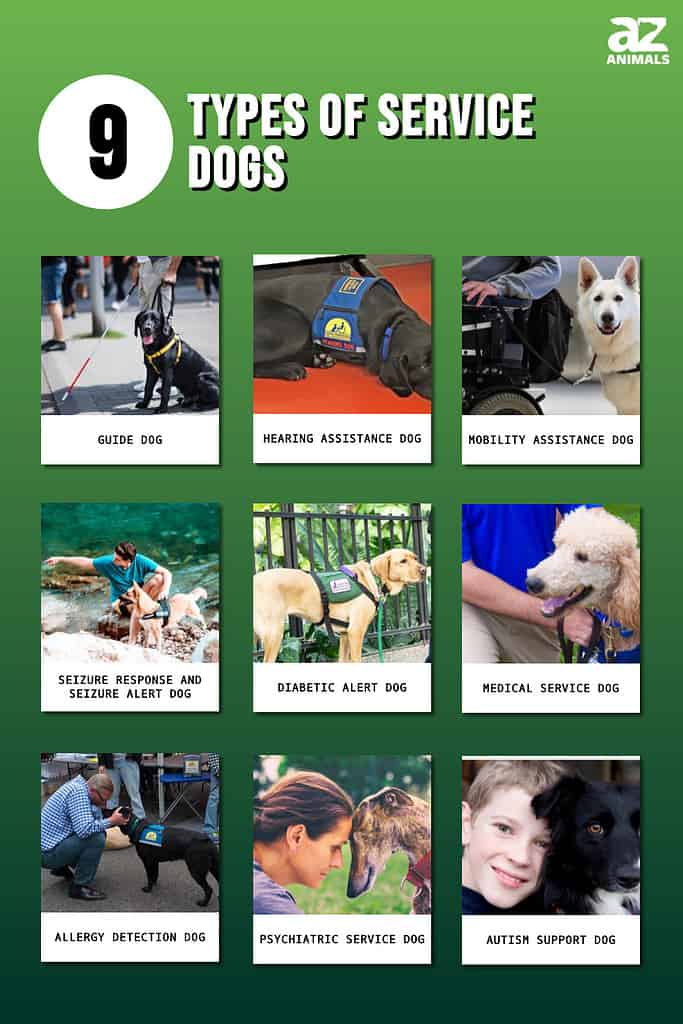
Service dogs are working dogs that are incredibly helpful to people for being able to perform necessary tasks on their behalf. But did you know that there are different types of service dogs? That’s right, service dogs can specialize in a field and learn to perform several related tasks.
The definition of a service dog is a working dog that is specially trained to perform specific tasks for an impaired person based on certain commands or triggers. Their assistance allows the impaired person to function more independently in their daily lives. Service dogs usually undergo dog training for tasks in a field since puppyhood or young age, and they often wear special vests in public. Because service dogs are more than companion animals and some people need them for essential, basic functions, they do not fit the definition of a pet and so are allowed where pets are not in order to accompany their person wherever they go. With that being said, here are the main types of service dogs.
1. Guide Dog
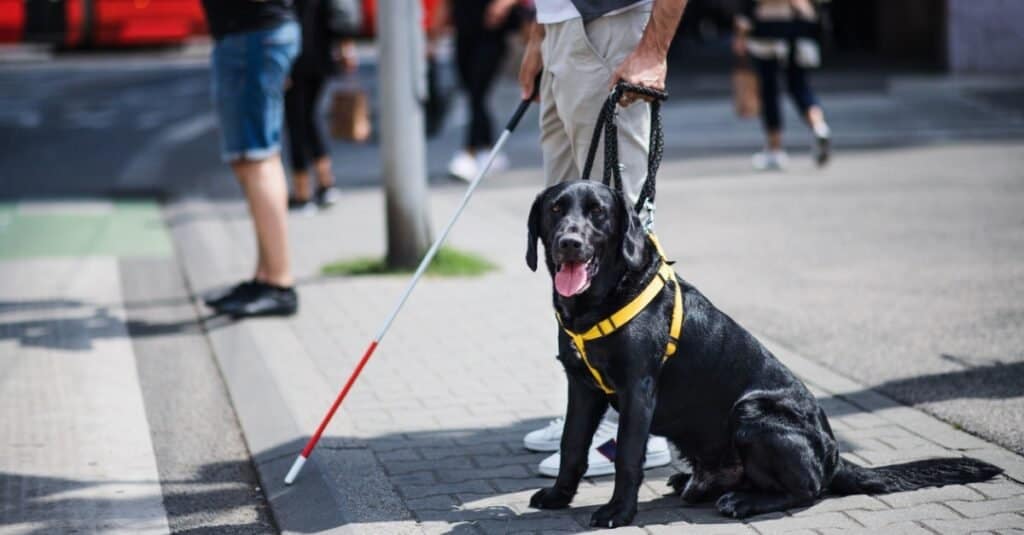
Guide dogs are trained to lead around obstacles, including hazards like low branches.
©iStock.com/Halfpoint
The guide dog, also called a seeing-eye dog, helps visually impaired people get around. It is trained to lead the human where they want to go and make sure it is safe, such as going up and down stairs, watching their step, or crossing the street. Perhaps the most common and one of the first types of service dogs around, the guide dog starts dog training from puppyhood for 12 to 24 months.
2. Hearing Assistance Dog
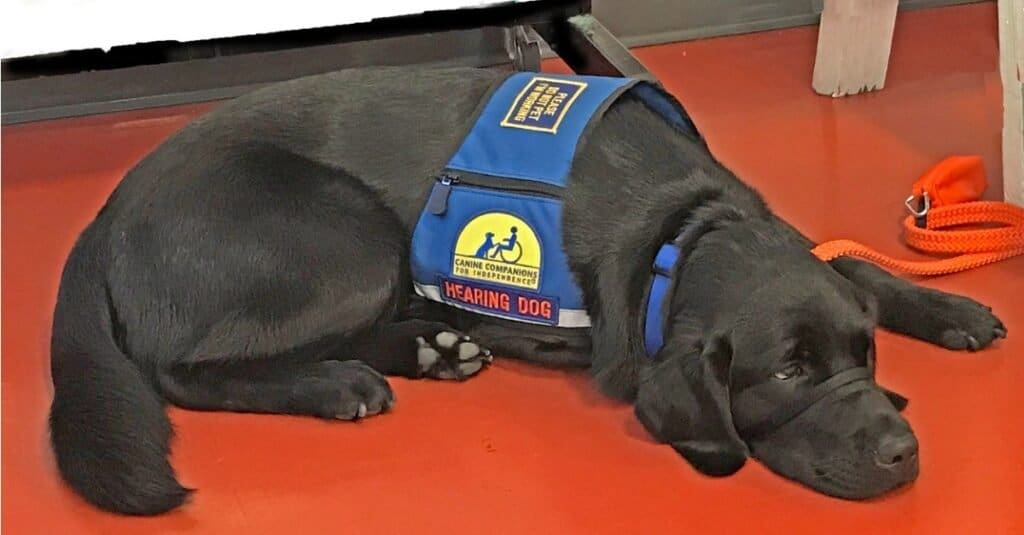
A hearing assistance dog can help people who are hard of hearing by alerting them to important sounds.
©iStock.com/cgshoots
Dogs are known for their exceedingly sharp sense of sound. They can even hear pitches that are out the human range of detectable sounds. For this reason, canines make excellent hunting companions and service dogs for the hearing impaired.
The hearing assistance dog helps people who are hard of hearing by alerting them to important sounds, such as alarms, the microwave, or doorbell ringing. It can be trained to perform up to 40 tasks and like the guide dog, has dog training of 1 to 2 years.
3. Mobility Assistance Dog
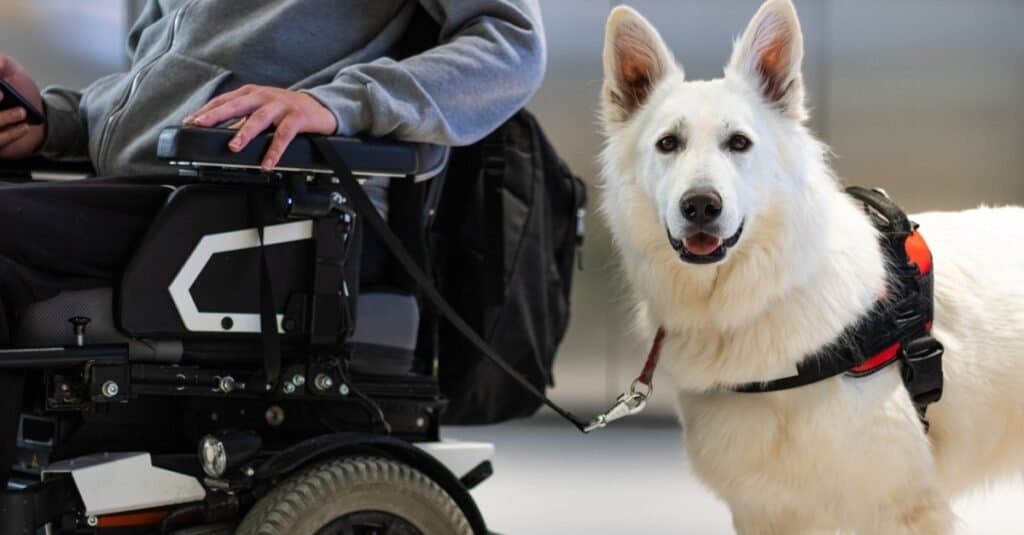
Mobility assistance dogs help people with mobility issues such as those in wheelchairs.
©24K-Production/Shutterstock.com
The mobility assistance dog helps people with mobility issues, such as those with arthritis or neurological conditions, be more independent. It does so by providing support for balance, dressing or undressing, pushing buttons on doors, picking up dropped items, carrying bags and other items, answering the door, getting the phone, and going up or down the stairs. This service dog tends to be a larger breed and dog training takes 18 to 24 months.
4. Seizure Response and Seizure Alert Dog

Seizure-alert dogs can sense and notify their human companions of an oncoming seizure.
©iStock.com/Biserka Stojanovic
The seizure response dog and the seizure alert dog are two types of service dogs for people with seizures. The seizure alert dog detects seizures before they happen, while the seizure response dog helps with seizures during or after. Both have dog training of at least two years, and some are also trained for mobility assistance.
5. Diabetic Alert Dog
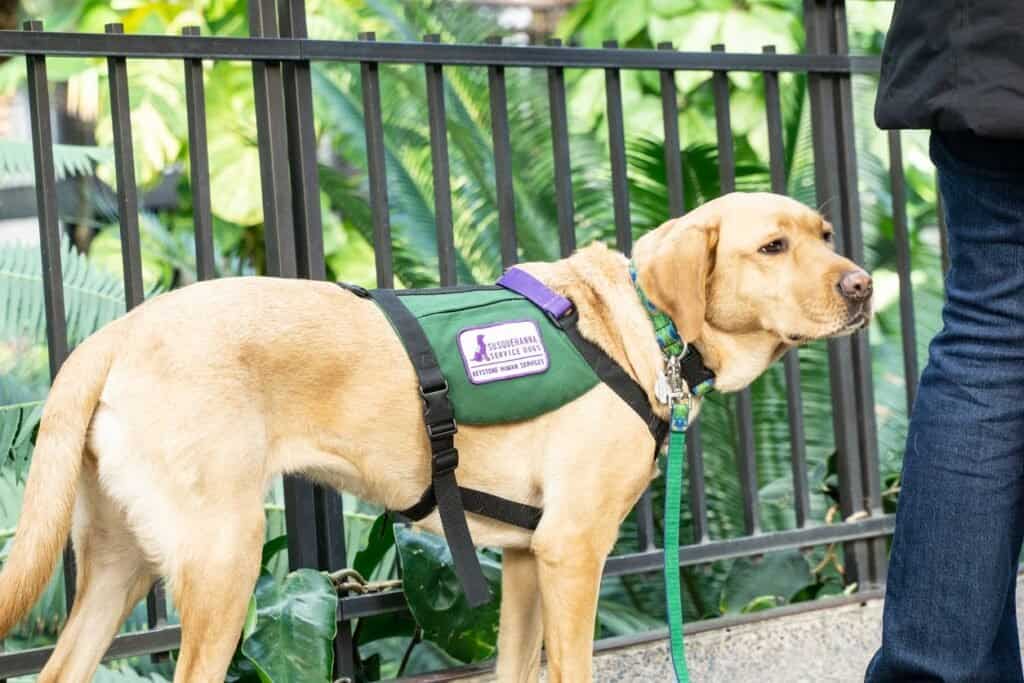
Diabetic alert dogs are trained to monitor for a specific scent on the human breath related to low blood sugar levels.
©iStock.com/arlutz73
The diabetic alert dog is a type of medical service dog that alerts people with diabetes of unhealthy blood sugar levels. Its dog training teaches it to detect insulin levels in saliva for a specific person and not only takes a minimum of two years but requires later matching with an applicant.
6. Medical Service Dog

A medical service dog can remind its handler to take medication and alert medical providers attention is needed.
©iStock.com/Laura Fay
Another major type of service dog, the medical service dog provides mobility assistance and performs medical services for people with medical issues other than hearing, diabetes, or epilepsy. It can remind its handler to take medication, alert medical providers of necessary medical attention, and more. Dog training takes about two years.
7. Allergy Detection Dog
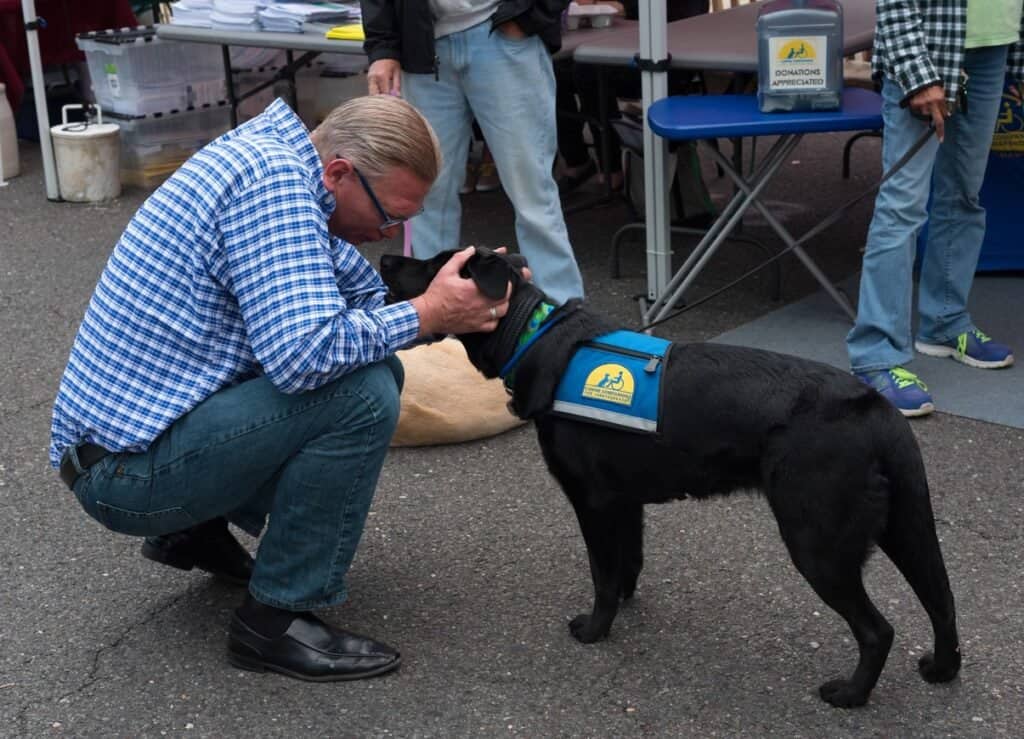
Allergy detection dogs are trained the same way as drug narcotics (scent) detection dogs and diabetic alert dogs combined.
©iStock.com/jfbenning
The allergy detection dog, like the diabetic alert dog, uses scent detection to help their handler in daily life. It is specially trained to detect the handler’s allergens and alert them with a certain pose that a harmful substance is nearby. Dog training takes 18 to 24 months.
8. Psychiatric Service Dog
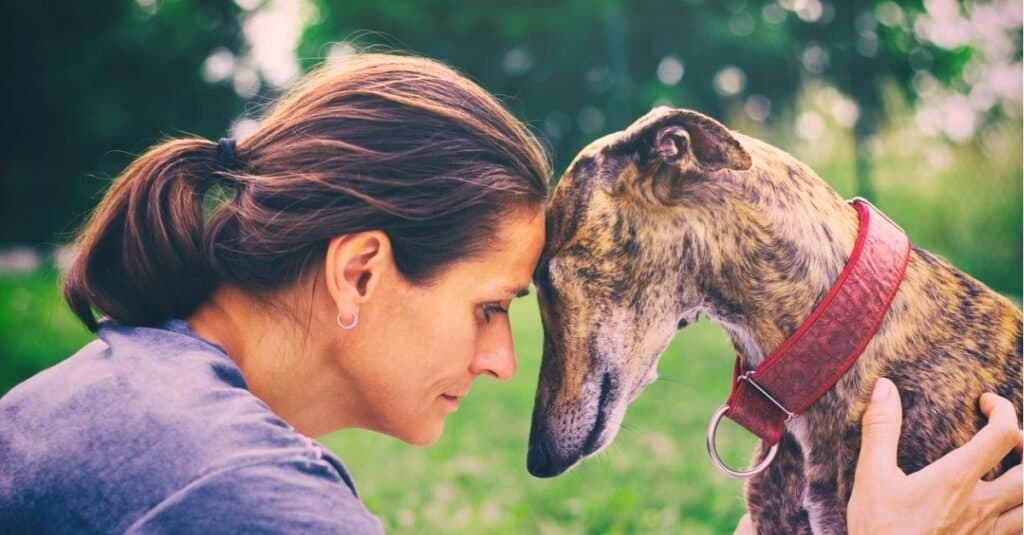
A psychiatric service dog is trained to assist its owner who has been diagnosed with a mental health condition.
©iStock.com/Zbynek Pospisil
Also called therapy dog and (inaccurately) emotional support dog, the psychiatric dog provides its handler with physical and emotional support for anxiety, PTSD, depression, schizophrenia, or other mental health issues. Sometimes, it’s called a PTSD dog or an anxiety support dog when it’s been trained for either because it is often used for such conditions. It can do so by giving comfort and assistance, such as cuddling during anxiety or a panic attack, reminding to take medication, disrupting self-harming behavior, de-escalating or alleviating emotional breakdowns, helping disoriented handlers, and other tasks as trained for necessity. Dog training takes one to two years.
9. Autism Support Dog

Service dogs for those with autism act as constant companions to help them improve social interactions.
©iStock.com/friedgreenbeans
The autism support dog provides support for adults and children with autism, although, in the children’s case, it is their parents who are the handlers. It is trained to give constant companionship and comfort in order to cope and be more independent in daily living, such as interrupting harmful behavior, alerting them to dangerous situations, or alerting their parents of important sounds. Dog training takes two years.
Breeds Used As Service Dogs
With so many different types of service dogs, are there are certain breeds used for each type? Yes. Here are the most common breeds and what kinds of services they excel in:
- Labrador Retriever: Guide, hearing, and mobility assistance
- Golden Retriever: Guide, hearing, medical alert, and psychiatric
- German Shepherd: Guide and seizure
- Greyhound: Psychiatric
- Poodle: Guide, hearing, mobility assistance, and medical alert
- Border Collie: Seizure, psychiatric
- Pomeranian: Hearing, medical alert, and psychiatric.
Service Dog vs. Emotional Support Dog vs. Therapy Dog
There is some confusion with regard to service dog terminology. The psychiatric service dog often gets mistakenly called an emotional support dog. Alternately, “service animal” is used interchangeably with “emotional support animal.” While the psychiatric service dog does provide emotional support, it provides physical support and needs professional training to be licensed as a service dog. It is not a pet and is very different from an emotional support animal, which only needs a doctor’s letter. Emotional support animals can be any animal, whereas service animals can only be dogs.
There’s also confusion between a service dog and a therapy dog. Although a psychiatric dog gets called a therapy dog, that’s not accurate. A therapy dog has dog training but it’s meant to interact with and provide comfort to a variety of people at public places, such as hospitals, schools, daycares, nursing homes, and rehabilitation centers, or even exclusively at single establishments. It can also be petted by people other than its handler.
If a dog is a man‘s best friend, then a working dog is a man’s best helper. A service dog is a type of working dog used for personal assistance, having undergone dog training to perform specialized tasks in a field. Different types of service dogs serve any one of several disabilities or medical conditions. These working dogs are important for helping people function in their daily lives, be more independent with regard to basic tasks, and achieve a better quality of life.
Summary of 9 Types of Service Dogs
Here’s a recap of the different service dogs we took a look at.
| Number | Category |
|---|---|
| 1 | Guide Dog |
| 2 | Hearing Assistance Dog |
| 3 | Mobility Assistance Dog |
| 4 | Seizure Response and Seizure Alert Dog |
| 5 | Diabetic Alert Dog |
| 6 | Medical Service Dog |
| 7 | Allergy Detection Dog |
| 8 | Psychiatric Service Dog |
| 9 | Autism Support Dog |
The photo featured at the top of this post is © iStock.com/Jennifer Blount
Ready to discover the top 10 cutest dog breeds in the entire world?
How about the fastest dogs, the largest dogs and those that are -- quite frankly -- just the kindest dogs on the planet? Each day, AZ Animals sends out lists just like this to our thousands of email subscribers. And the best part? It's FREE. Join today by entering your email below.
Thank you for reading! Have some feedback for us? Contact the AZ Animals editorial team.







